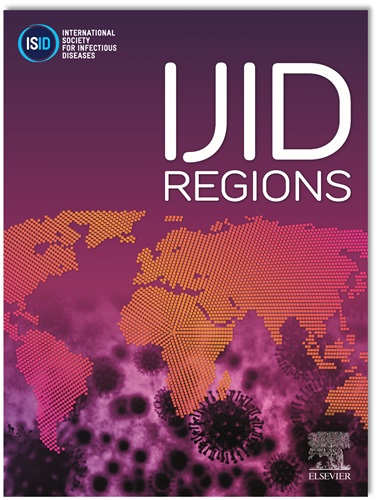急性发热性呼吸道疾病全年感染组分析揭示了解除COVID-19限制后复杂的流行病学动态。
IF 4.3
2区 医学
Q1 INFECTIOUS DISEASES
引用次数: 0
摘要
目的:在中国取消COVID-19非药物干预措施后,呼吸道感染激增,但具体原因尚不清楚。本研究提供了急性发热性呼吸道疾病(AFRI)患者感染组的全面概述,为疾病监测提供信息。方法:2023年3月至2024年2月,在深圳采集AFRI患者口咽拭子1163份,健康人群口咽拭子338份。采用元转录组测序进行微生物分析。结果:我们鉴定出14种病毒和10种已知引起人类疾病的细菌。流感病毒、SARS-CoV-2、肺炎链球菌和红dondovirus最常见,H3N2与SARS-CoV-2呈负相关。值得注意的是,我们检测到了某些肠道病毒亚型(如柯萨奇病毒A6和埃可病毒30),以前被忽视的病原体(如红dondovirus),以及罕见的病原体,如假性肺炎链球菌。比较显示,五种病原体在患者中的丰度明显高于对照组,尽管其他病原体没有显著差异,这可能是由于阳性池数量有限。微生物多样性和组成的季节变化与温度和降水等气候因子有关。系统发育分析揭示了基因型多样性和优势病原体谱系的变化。结论:本研究强调了受COVID-19限制的AFRI患者的复杂病原体感染,证明了meta转录组学比基于pcr的方法在更详细的病原体监测方面的价值。本文章由计算机程序翻译,如有差异,请以英文原文为准。
Year-round infectome profiling of acute febrile respiratory illness unveiled complex epidemiological dynamics postlifting of COVID-19 restrictions
Objectives
Following the lifting of COVID-19 nonpharmaceutical interventions in China, respiratory infections surged, though the specific causes remained unclear. This study provided a comprehensive overview of the infectome in patients with acute febrile respiratory illness (AFRI) to inform disease surveillance.
Methods
Between March 2023 and February 2024, 1163 oropharyngeal swabs from AFRI patients and 338 from healthy individuals were collected in Shenzhen. Meta-transcriptomic sequencing was employed for microbial analysis.
Results
We identified 14 viruses and 10 bacteria species known to cause human disease. Influenza virus, severe acute respiratory syndrome coronavirus 2 (SARS-CoV-2), Streptococcus pneumoniae, and redondovirus were the most common, with a negative correlation between H3N2 and SARS-CoV-2. Notably, we detected certain enterovirus subtypes (e.g., Coxsackievirus A6 and Echovirus 30), previously overlooked pathogens (e.g., redondovirus), and rare pathogens like Streptococcus pseudopneumoniae. Comparisons revealed five pathogens showed significantly higher abundance in patients than in controls, despite no significant differences for others probably due to their limited number of positive pools. Seasonal shifts in microbial diversity and composition were observed, with climate factors like temperature and precipitation playing a role. Phylogenetic analysis revealed changes in genotype diversity and dominant pathogen lineages.
Conclusion
This study highlighted complex pathogen infections in AFRI patients following COVID-19 restrictions, demonstrating the value of meta-transcriptomics over PCR-based methods for more detailed pathogen surveillance.
求助全文
通过发布文献求助,成功后即可免费获取论文全文。
去求助
来源期刊
CiteScore
18.90
自引率
2.40%
发文量
1020
审稿时长
30 days
期刊介绍:
International Journal of Infectious Diseases (IJID)
Publisher: International Society for Infectious Diseases
Publication Frequency: Monthly
Type: Peer-reviewed, Open Access
Scope:
Publishes original clinical and laboratory-based research.
Reports clinical trials, reviews, and some case reports.
Focuses on epidemiology, clinical diagnosis, treatment, and control of infectious diseases.
Emphasizes diseases common in under-resourced countries.

 求助内容:
求助内容: 应助结果提醒方式:
应助结果提醒方式:


